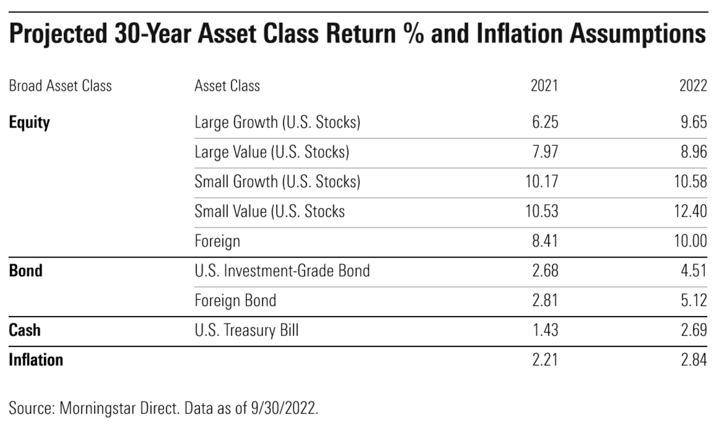Investing for the long run is easier if you temper your emotions with the knowledge that lower stock and bond prices today suggest higher future returns (and vice versa). Morningstar has just released the 2022 edition of their research paper The State of Retirement Income (e-mail required, intro article), where they point out this silver lining:
Because equity valuations have declined and cash and bond yields have increased, the forward-looking prospects for portfolios—and in turn the amounts that new retirees can safely withdraw from those portfolios over a 30-year horizon—have enjoyed a nice lift since we explored the topic last year.
Whereas last year’s research suggested that a 3.3% withdrawal rate was a safe starting point for new retirees with balanced portfolios over a 30-year horizon, this year’s research points to 3.8% as a safe starting withdrawal percentage, with annual inflation adjustments to those withdrawals thereafter.
I haven’t processed the entire 29-page paper yet, but here’s a chart summarizing the differences between the future outlooks in 2021 and 2022. Quite a difference in only a year.

None of these numbers are guaranteed of course (in fact they are virtually guaranteed to be wrong), but step back and look and the big picture. Lower P/E ratios and a higher starting interest rate definitely provide a stronger investing base. You are buying businesses at a lower price and your bonds can again provide cushion now that interest rates have room to fall. As long as you are a buyer, this is a good thing.
 The Best Credit Card Bonus Offers – October 2024
The Best Credit Card Bonus Offers – October 2024 Big List of Free Stocks from Brokerage Apps
Big List of Free Stocks from Brokerage Apps Best Interest Rates on Cash - October 2024
Best Interest Rates on Cash - October 2024 Free Credit Scores x 3 + Free Credit Monitoring
Free Credit Scores x 3 + Free Credit Monitoring Best No Fee 0% APR Balance Transfer Offers
Best No Fee 0% APR Balance Transfer Offers Little-Known Cellular Data Plans That Can Save Big Money
Little-Known Cellular Data Plans That Can Save Big Money How To Haggle Your Cable or Direct TV Bill
How To Haggle Your Cable or Direct TV Bill Big List of Free Consumer Data Reports (Credit, Rent, Work)
Big List of Free Consumer Data Reports (Credit, Rent, Work)
On the other hand, you now have lost the appreciation of your equity portfolio and so 3.8% of a smaller portfolio is less money. What am I missing here?
I question the value of this sort of prediction. The article predicts stock market yield, interest rates and inflation over the next 30 years to the 1/100th of a percent. We can’t even predict what they will be next month, and should not worry about that. Make your plan and stay the course.
Wait, the chart lists inflation at 2.2-2.8%… I thought I read that “the annual inflation rate in the US ‘slowed’ for a fifth straight month to 7.1% in November of 2022… How can it suddenly be near the Fed’s target level of 2%?
You read about current inflation. In the title of the table it says “Projected 30-year…” ?
Dang, it didn’t allow emoji in my comment. “?” = :facepalm: